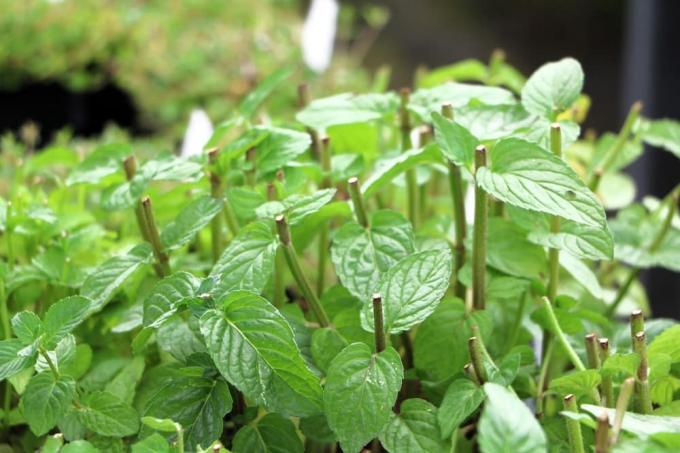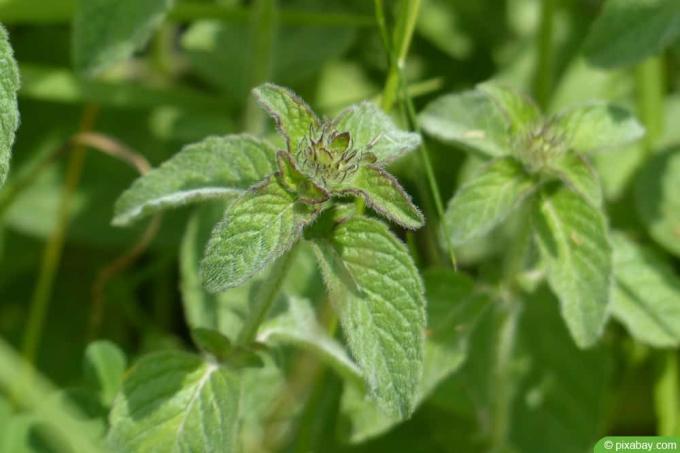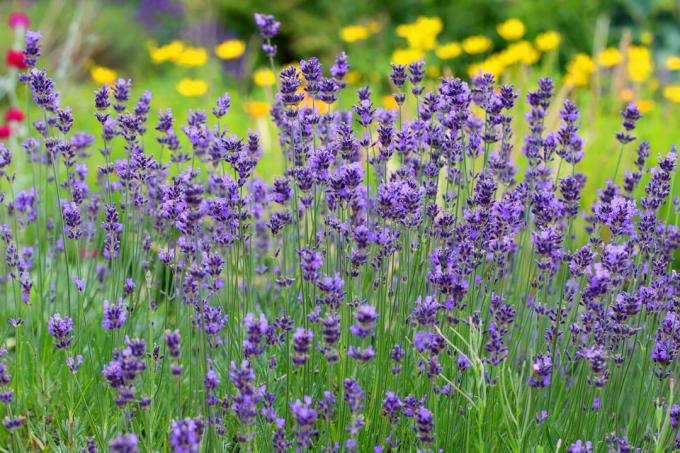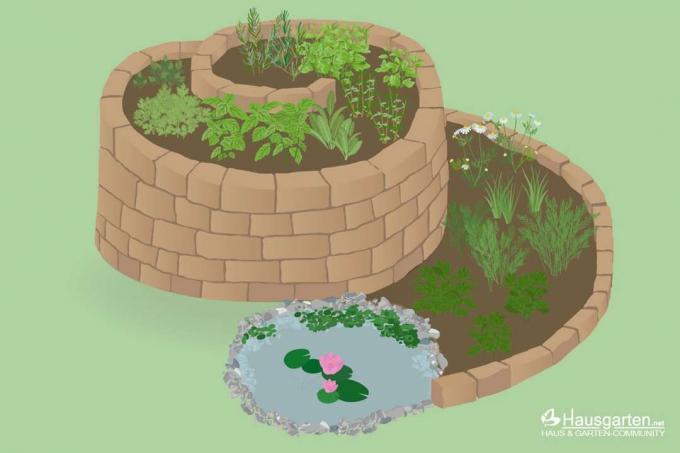

Table of contents
- cultivation
- Popular varieties from A to E
- Popular varieties from L to P
- Popular varieties from S to Z
Mint (Mentha) belongs to the mint family and is one of the most well-known medicinal plants. Essential oils result in the fresh aroma typical of all types of mint. The medicinal herb is used as a tea for colds and sore throats. It is added to medicinal baths and relieves headaches. Mint is incorporated into refreshing beverages, desserts, and treats. We present 12 varieties for self-cultivation.
cultivation
Most mint varieties are perfect for growing in the garden. If you don't have a garden, you can also achieve good results on the balcony or on the windowsill. The plant needs loose, nutrient-rich soil and sufficient moisture. Choose a sunny to partially shaded location. Note that mint forms extensive roots and is profusely rampant both above and below ground. Root barriers and continuous pruning are recommended.
Mints are considered to be very robust plants. They are commonly attacked by aphids, flea beetles, mint bears, and fungal diseases such as powdery mildew and mint rust. Mints are hardy and can easily overwinter outdoors covered with brushwood. Mints in tubs need a sheltered location on the wall of the house or in the basement. We recommend a cover made of jute or bubble wrap for protection.
Popular varieties from A to E
pineapple mint(Mentha suaveolens variegata)

A very beautiful variety is the pineapple mint with its white-edged, slightly hairy leaves. Pineapple mint convinces with a fruity pineapple aroma and a milder menthol taste. It is often used for children's teas.
- Height: up to 70 centimeters
- Harvest: May until October
- Blossoms: light pink
- Use as a medicinal herb: antispasmodic, cooling and antipyretic, anti-inflammatory
- Use as a herb: Tea, salads, desserts, bouquets
Tip:
If you rub the white-edged leaves of pineapple mint between your fingers, you will be spoiled with a wonderful scent of pineapple. Arranged in the vase, just a few stalks of pineapple mint spread a wonderful scent in the apartment.
apple mint(Mentha rotundifolia)
Apple mint is one of the most popular fruit mints. It exudes a wonderful aroma. The variety has a low menthol content and is suitable for children's teas.
- Height: 60 to 80 centimeters
- Harvest: May to September
- Blossoms: white
- Use as a medicinal herb: relieves inflammation of the oral mucosa, calming, relaxing
- Use as a herb: Tea, soft drinks, desserts, syrups, liqueurs, vinegar, scented bouquets
basil mint(Mentha piperita x citrata basil)

The basil mint combines the spiciness of basil and a slightly peppery taste with a fresh mint aroma. This mixture is perfect for preparing pesto and Mediterranean dishes.
- Height: 60 to 80 centimeters
- Harvest: May to September
- Blossoms: purple
- Use as a medicinal herb: anti-inflammatory, calming, refreshing, cooling
- Use as a herb: Pesto, soups, salads, vegetable dishes
strawberry mint(Mentha Species)

Strawberry mint is one of the smallest mint varieties. But the dainty plant impresses with its wonderful strawberry aroma. It makes few demands on its location and grows outdoors as well as on the balcony or on the windowsill.
- Height: 30 to 50 centimeters
- Harvest: May to September
- Blossoms: light purple
- Use as a medicinal herb: relieves cold symptoms, coughs and hoarseness, reduces bad breath, has a relaxing effect on stomach and intestinal problems
- Use as a herb: Tea, desserts, liqueurs, soups, salads, cocktails
Popular varieties from L to P
lavender mint(Mentha Species)
Lavender mint does not overgrow like other mint varieties. She is petite and grows slowly. It gives off a pleasant, sweet fragrance and is ideal for making bouquets, potpourris and additives for relaxing baths.
Lavender mint is very important in Mediterranean cuisine.
- Height: 40 to 50 centimeters
- Harvest: May to September
- Blossoms: light purple
- Use as a medicinal herb: relaxing, calming, relieves insomnia
- Use as a herb: Mediterranean vegetable dishes, scented bouquets, bath additives
Moroccan mint(Mentha spicata var. Crispa Morocco)
Moroccan mint comes from Morocco, where it is traditionally made into a tea and drunk with lots of sugar. It originated from the curly mint (Mentha spicata).
- Height: 40 to 60 centimeters
- Harvest: May to September
- Blossoms: light purple
- Use as a medicinal herb: relieves cold symptoms and sore throat, antispasmodic, digestive
- Use as a herb: Tea, cocktails, lemonade, salads
Tip:
For a quarter liter of refreshing mint tea you need a sprig of peppermint or Moroccan mint. Pour 250 milliliters of boiling water on it. Let the tea steep for 10 minutes and enjoy the healthy drink. If you like, you can sweeten the mint tea with honey.
Nana mint(Mentha spicata var. crispa Nane)
Nana mint comes from the Near East. It is also known as Turkish mint. It is used in oriental cuisine to flavor dishes. Nana mint is mainly drunk with black tea and lots of sugar. Nana mint is milder than peppermint and is considered better tolerated.
- Height: 60 to 80 centimeters
- Harvest: May to September
- Blossoms: pink
- Use as a medicinal herb: relieves cold symptoms, anti-inflammatory, calming, promotes digestion
- Use as a herb: Tea, cocktails, salads, yogurt, dips
orange mint(Mentha piperita citrata)

The orange mint impresses with its refreshing aroma of ripe oranges. The menthol content of the variety is low, so orange mint is excellent for children's teas.
- Height: 40 to 60 centimeters
- Harvest: May to September
- Blossoms: pink
- Use as a medicinal herb: antispasmodic, cooling and antipyretic, anti-inflammatory
- Use as a herb: Tea, salads, desserts, mint vinegar, bouquets and potpourris
Tip:
One pest that likes to attack orange mint is the mint bear. The iridescent green beetles are pretty to look at. If they are not dealt with in time, they will eat up your mints in a short time. Watch out for the beetles in the spring and collect them carefully. This stops mating and your plants are protected from the voracious beetle.
peppermint(Mentha x piperita)

Peppermint has been used for centuries. It was made from brook mint and wood mint. It is also known as English mint or garden mint.
Incidentally, peppermint is one of the most important herbs in British cuisine. Even meat dishes are served with aromatic peppermint sauces. Peppermint is also often used in Arabic cuisine to refine rice and bulgur dishes.
- Height: 50 to 65 centimeters
- Harvest: May to September
- Blossoms: white-purple
- Use as a medicinal herb: relieves cold symptoms, sore throat and headaches, digestive, antispasmodic
- Use as a herb: Tea, cocktails, ice cream, sweets, sauces, salads
A notice:
Peppermint tea is healthy, but should not be drunk all the time. The high menthol content can lead to irritation of the gastric mucosa if consumed regularly. Mild types of mint such as apple, orange or strawberry mint contain less menthol and are easier on the stomach.
Popular varieties from S to Z
chocolate mint(Mentha x piperita var. piperita chocolate)

Anyone expecting chocolate mint to taste like chocolate will be disappointed. The mint variety got its name from its use in English mint tablets. Nonetheless, chocolate mint is a wonderful culinary herb that adds a delicious flavor to desserts, with or without chocolate.
In contrast to most other mints, the plant prefers a semi-shady to shady location.
- Height: 30 to 60 centimeters
- Harvest: May to September
- Blossoms: violet blue
- Use as a medicinal herb: antispasmodic, calming, nerve-strengthening, cooling
- Use as a herb: Tea, cakes, desserts, ice cream, cocktails
Tip:
The flowering, fragrant mint varieties attract bees, bumblebees, butterflies, and many beneficial insects.
water mint(Mentha aquatica)

Water mint is also known as brook mint. The swamp plant is widespread in large parts of Europe, in swampy areas, on stream banks and wet meadows. Water mint is one of the sacred herbs of the druids. It has been used as a medicinal plant for centuries.
- Height: 20 to 50 centimeters
- Harvest: May to September
- Blossoms: light purple
- Use as a medicinal herb: relieves stomach and bile disorders, helps with insomnia, reduces headaches
- Use as a herb: tea, bath additives
lemon mint(Mentha gentilis var. citrate)

The lemon mint spoils with a wonderful citrus scent paired with a hint of menthol. Lemon mint is excellent for making fragrant bath oils.
- Height: 20 to 40 centimeters
- Harvest: May to September
- Blossoms: light purple
- Use as a medicinal herb: relieves cold symptoms, calming, nerve-strengthening, invigorating, anti-inflammatory
- Use as a herb: Smoothies, tea, desserts, liqueurs, soups, salads, aromatic oils
Tip:
A foot bath with mint has a wonderfully relaxing effect in both summer and winter. Put five sprigs of your favorite mint in a liter of hot water and let the mixture steep for ten minutes. Pour the mint water into a suitable vessel. Fill the foot bath with two liters of hot water and enjoy the effect.
 Home editorial office
Home editorial office
Learn more about growing herbs

Basil has black dots: what to do?
Especially basil bought in a pot from the supermarket tends to quickly develop black dots or spots on the leaves. This article explains why this is and what helps against it.

14 kitchen herbs that you can really keep in the kitchen
Sometimes a herb garden is only possible on the windowsill. If you don't have your own garden bed, for example, or in the months when the frost freezes the coveted greenery outside. Our list provides an overview of which herbs like the kitchen location permanently.

Parsley turns yellow: Four tips against yellow leaves
If the leaves of the parsley suddenly turn yellow, the so-called parsley disease is usually behind it. This can have many causes. If the outbreak of the disease is to be prevented, only prevention helps. More about this here.

You can combine lavender with these 13 plants
Whether you use it in the kitchen, want to enjoy its fragrance or its beauty, lavender is a must in any garden. Well combined, it can strengthen other plants or protect them from pests. We present the best plant neighbors.

8 tips for cutting and harvesting herbs properly
Fresh herbs from the garden should not be missing in any kitchen. They are versatile, exude pleasant and spicy scents and are a treat for the eye with their pretty flowers. In the kitchen, they can easily replace artificial flavor enhancers.

Herb spiral & herb snail: this is how it's done
A herb spiral or herb snail makes it possible to plant many different varieties in a particularly decorative way. However, this is not the only advantage of these variants of the culture. You can find out how to create them here.



